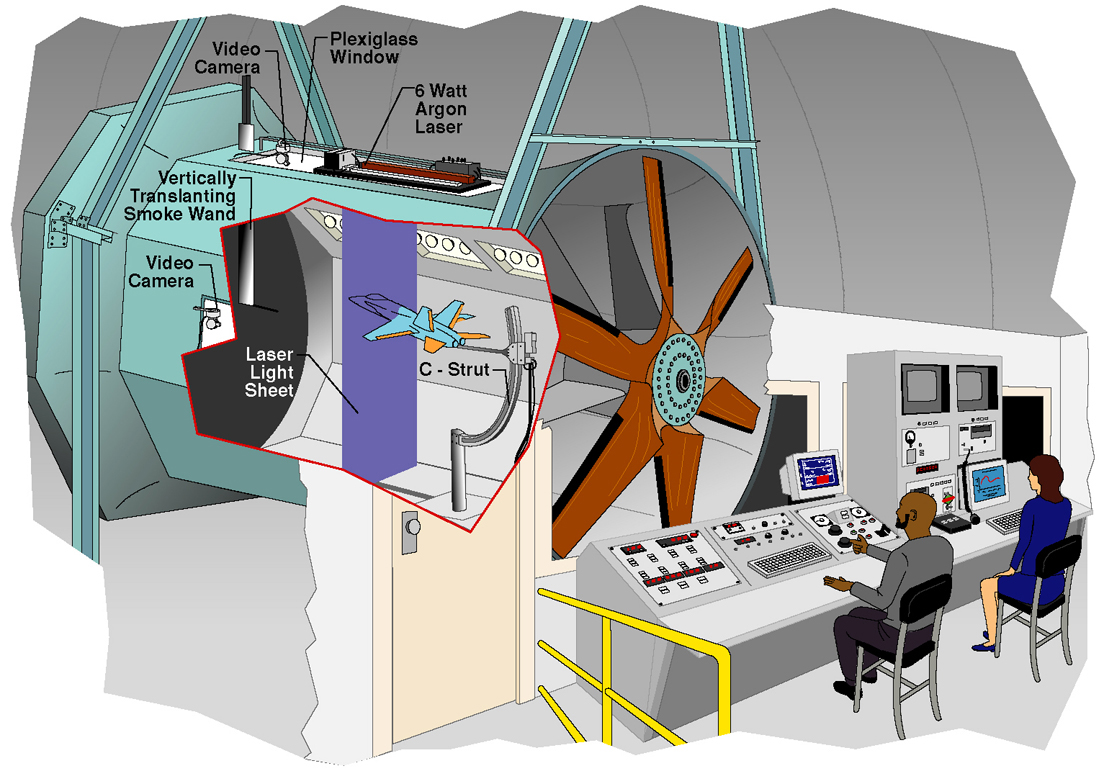Test Section & Performance
The Langley 12-Foot Low-Speed Tunnel (12-Ft LST) is an atmospheric pressure, open circuit tunnel enclosed in a 60-foot diameter sphere. The test section is octagonal with a width and height of 12 feet and a length of 15 feet with each octagonal side measuring 5 feet. The maximum operating pressure is q=7psf (V=77 ft/sec at standard sea level conditions) which corresponds to a Reynolds number of approximately 492,000 per foot. The longitudinal center-line-flow in the test section has a turbulence level of about 0.6 percent. Test section airflow is produced by a 15.8-ft. diameter, 6-blade drive fan powered by a 280 HP, 600 volts, 600 RPM DC motor which is controlled by a 500 HP AC motor, that drives a field controlled generator.
Model Observation
Direct observation of the test is available during tunnel operations through large control room windows. Also S-VHS video cameras and video tape decks are available for recording views of the model and test section while the tunnel is operating or recording flow visualization results.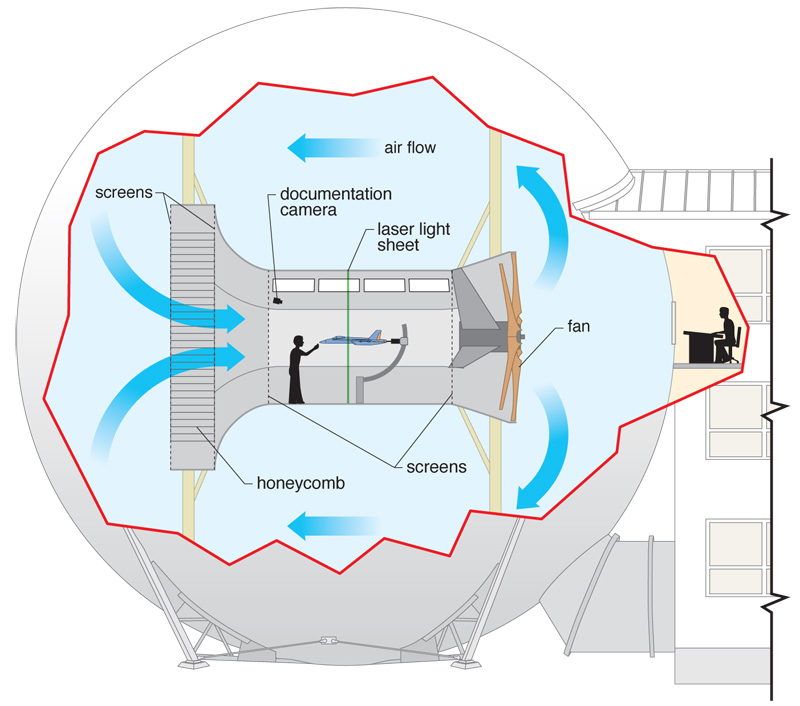
Data Acquisition and Processing
The 12-Ft LST static and dynamic data acquisition system is a UNIX based computer system and is used to acquire and store static or dynamic force, moment, and surface pressure measurement data, as well as for rig motion control. Data reduction is available on line and the data is available for plotting at the end of each run. All data are stored on disks and can be converted to most standard formats
Safety and Design Criteria
Langley’s LHB 1710.15 Wind Tunnel Model System Criteria is the guideline for model design and fabrication. Model installation and any exceptions to this document must have the approval of the 12-Ft LST Safety Head on a case-by-case basis to assure personnel and tunnel hardware are not exposed to risk.
Facilities Available to Users
The work conducted in 12-Foot Tunnel is generally exploratory research for the screening and refinement of advanced aerospace technologies and vehicle concepts. Much of this research focuses on stability and control characteristics, and on understanding the steady and time-dependent aerodynamics responsible for these characteristics. Because the aerodynamic loads are low, many tests can be conducted with relatively simple and inexpensive models constructed of fiberglass, foam, and wood. These models are typically designed to allow quick assessment of a wide range of configuration changes. Tests conducted in the 12-Foot Tunnel with external partners are usually performed as cooperative research activities, and must provide research content that benefits NASA. Potential users should contact the 12-Foot Low-Speed Tunnel Manager to discuss research opportunities and model/test requirement.
Testing Capabilities
Langley’s LHB 1710.15 Wind Tunnel Model System Criteria is the guideline for model design and fabrication. Model installation and any exceptions to this document must have the approval of the 12-Ft LST Safety Head on a case-by-case basis to assure personnel and tunnel hardware are not exposed to risk.
- Static Force Testing
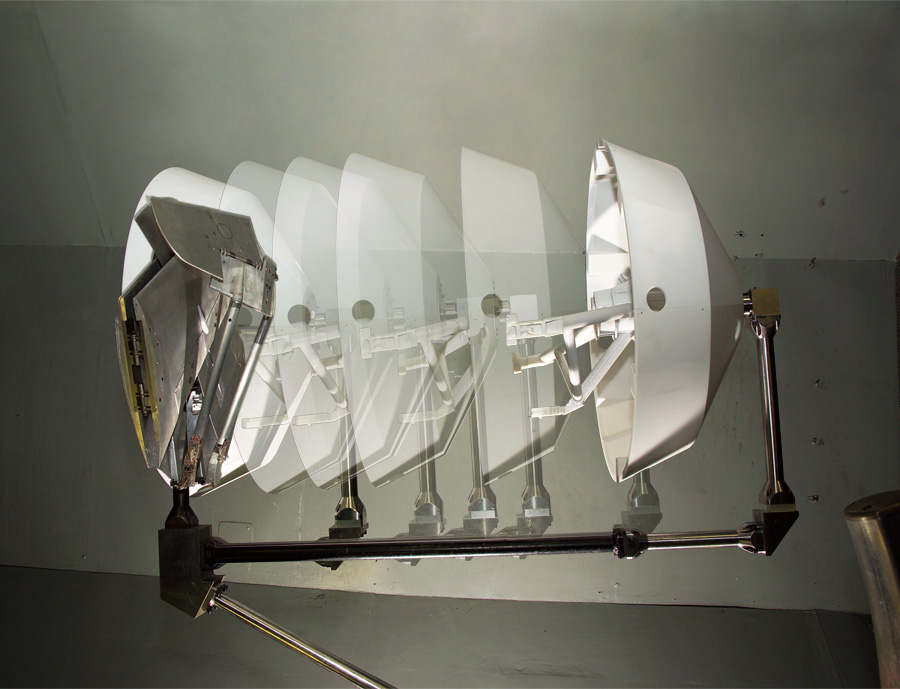
Models for static test are mounted on a sting attached to a C-strut. The sting is moved along the C-strut to change the angle of attack from -10 deg. to 90 deg. The strut is rotated about a vertical axis to change the angle of sideslip from -90 deg. to 90 deg. The C-strut also has a vertical range of travel of 2 feet, which allows for a top or bottom model mount. The sting is capable of supporting models weighing up to 180 pounds. Non-dynamically scaled models with an internally mounted strain-gage balance are tested for static force and moment data. Power effects can be investigated during static tests by specially equipping a model with air lines and using compressed air to simulate power with model ejectors or to drive a propeller with an air motor. Pressure data can also be taken and reduced to pressure coefficients during static testing.
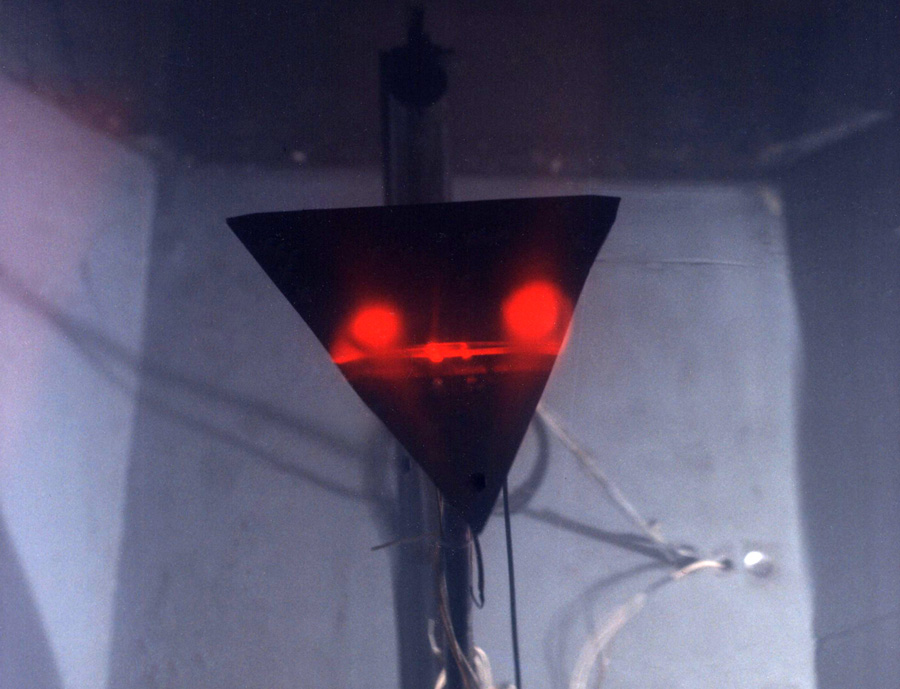
- Flow Visualization Testing
The 12-Foot Tunnel can support several types of flow visualization techniques including tufts (yarn or Mylar), propylene glycol smoke and a laser light sheet. When using florescent mini tufts a black light is available to illuminate the tufts instead of the regular white light used in the test section.
- Free-to-Roll Testing
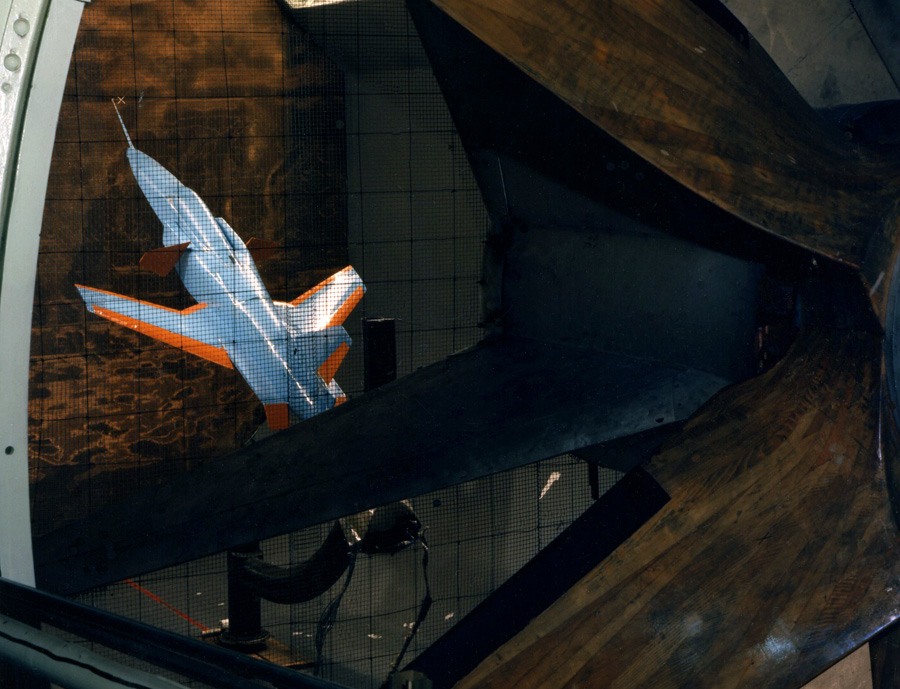 The same model support and sting are used for free-to-roll testing. This technique isspecifically used to investigate a model’s wing rock tendencies. For this type of testing the model is mounted on the free-to-roll apparatus which consist of two ball bearings and a potentiometer, and allows a model to move freely about its roll axis. Time histories of roll angle data are used to determine the wing rock magnitude and frequency as well as to estimate the rolling moment coefficient of the model in motion. The model for this type of test must be statically balanced in roll and the weight not to exceed 180 pounds.
The same model support and sting are used for free-to-roll testing. This technique isspecifically used to investigate a model’s wing rock tendencies. For this type of testing the model is mounted on the free-to-roll apparatus which consist of two ball bearings and a potentiometer, and allows a model to move freely about its roll axis. Time histories of roll angle data are used to determine the wing rock magnitude and frequency as well as to estimate the rolling moment coefficient of the model in motion. The model for this type of test must be statically balanced in roll and the weight not to exceed 180 pounds.
- Dynamic Pitch Testing
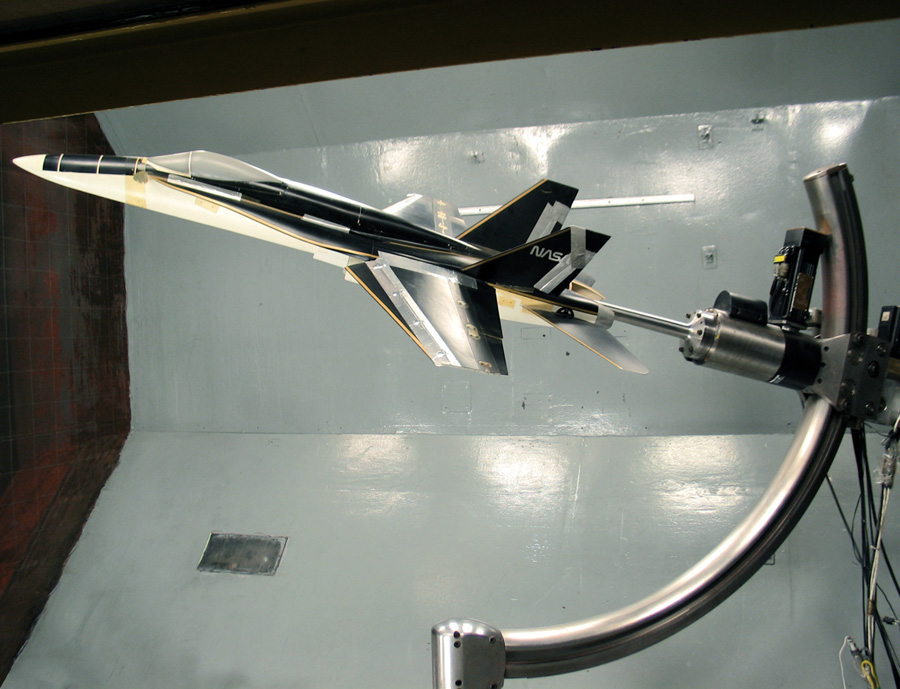 Forced pitch oscillation testing is conduced using a specially designed pitch rig that mounts on the static sting and has a range of 90 degrees. The pitch rig is capable of generating very rapid pitch rates on a model undergoing any programmable motion in order to study unsteady loads and flow behavior during dynamic maneuvers. Time history data are collected and compared to regular static data to determine the lag effects due to the dynamic movements. The model for this type of test must be statically balanced and is limited to 20 pounds.
Forced pitch oscillation testing is conduced using a specially designed pitch rig that mounts on the static sting and has a range of 90 degrees. The pitch rig is capable of generating very rapid pitch rates on a model undergoing any programmable motion in order to study unsteady loads and flow behavior during dynamic maneuvers. Time history data are collected and compared to regular static data to determine the lag effects due to the dynamic movements. The model for this type of test must be statically balanced and is limited to 20 pounds.
Future Test Techniques
A dynamic-force test rig is under development that will allow the standard forced oscillation derivatives to be measured about the roll or yaw axes. The dynamic roll and yaw rig has an amplitude of +/-170 degrees and is designed to be interchangeable with the existing static sting and operate on the C-strut. This will allow for an unlimited angle of attack and
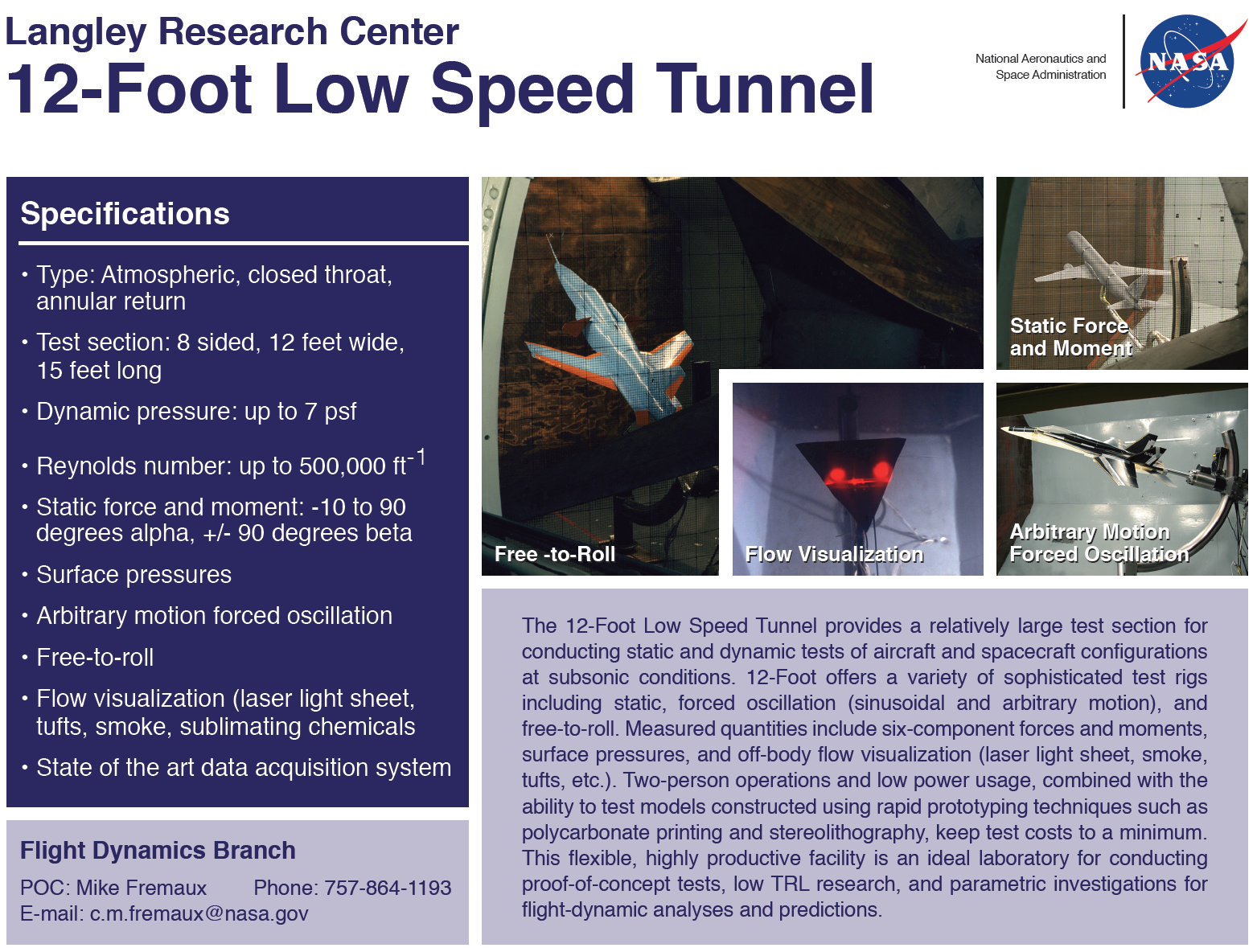 sideslip capability. The frequency of this motion will be determined by the velocity and amplitude required. In addition to forced oscillation the rig is capable of undergoing any programmable motion for which time history data is requested. The model for this type of testing is limited to 90 pounds.
sideslip capability. The frequency of this motion will be determined by the velocity and amplitude required. In addition to forced oscillation the rig is capable of undergoing any programmable motion for which time history data is requested. The model for this type of testing is limited to 90 pounds.

